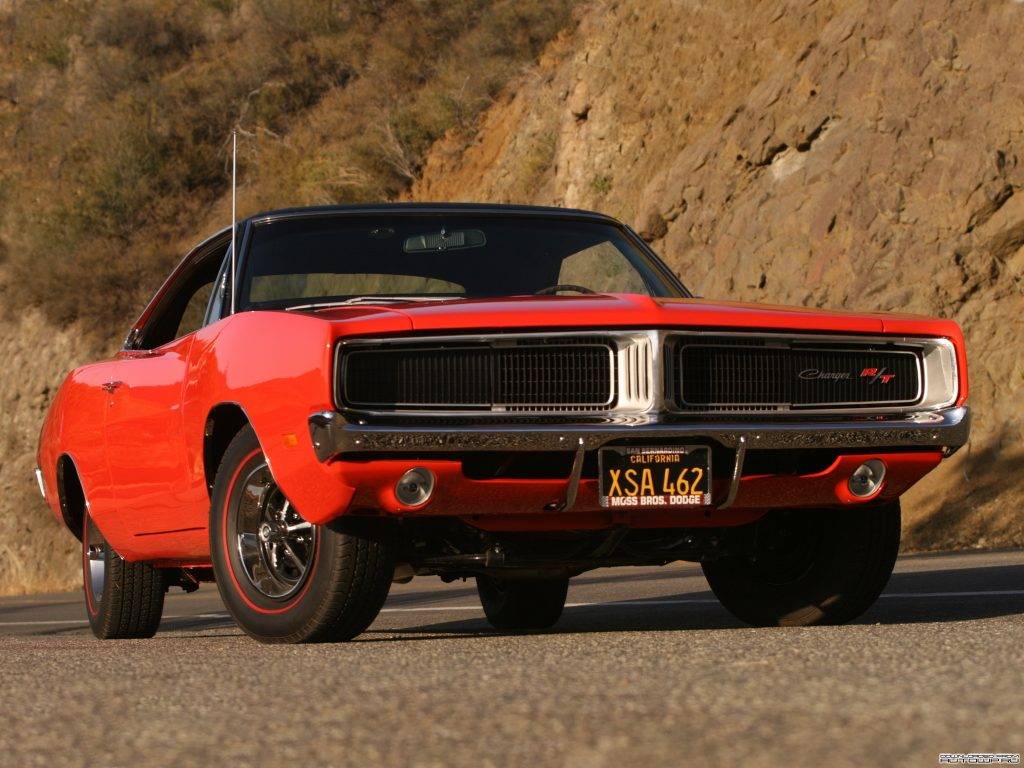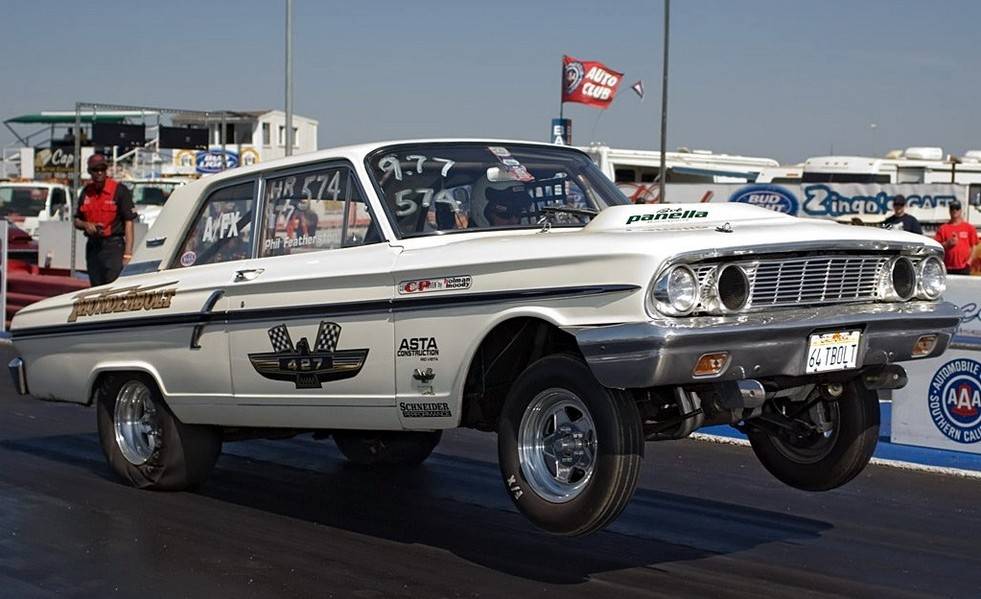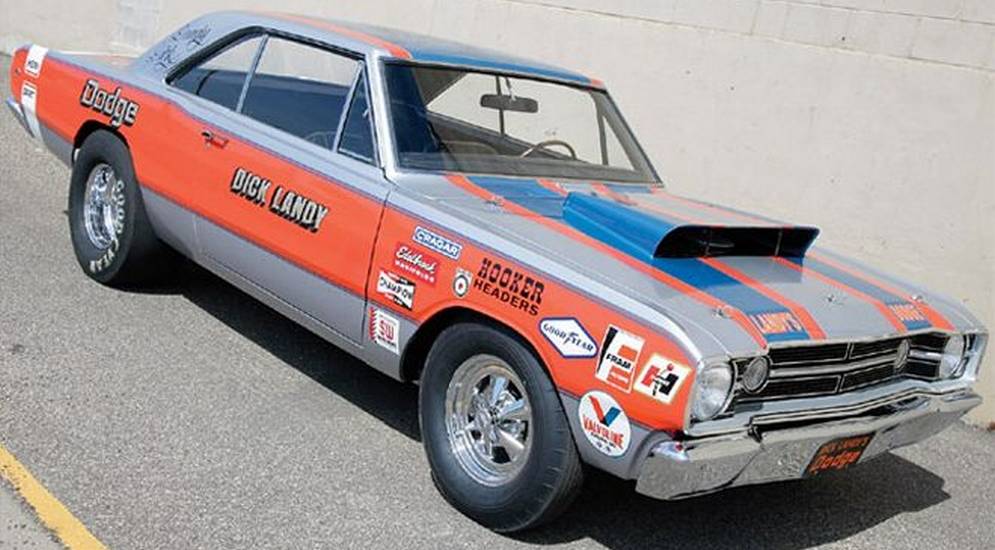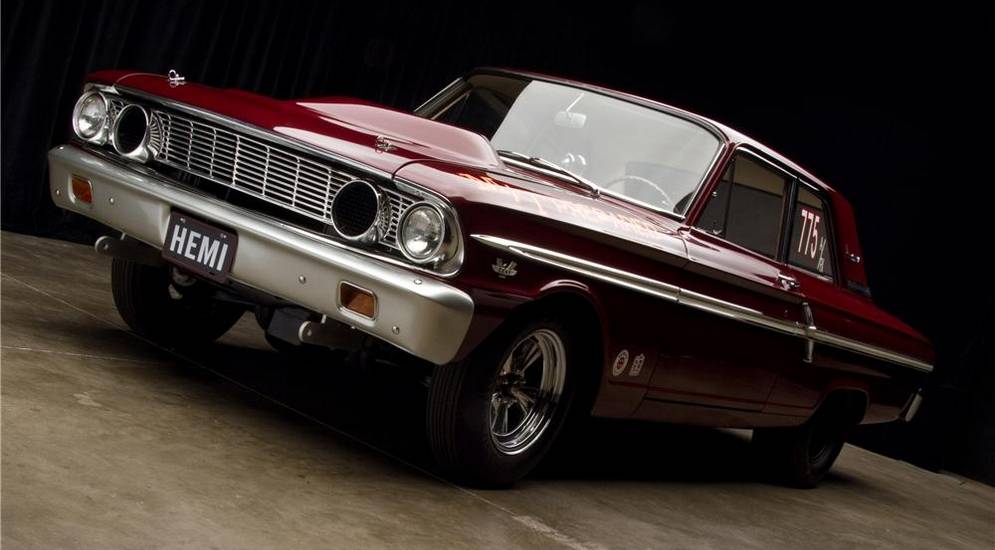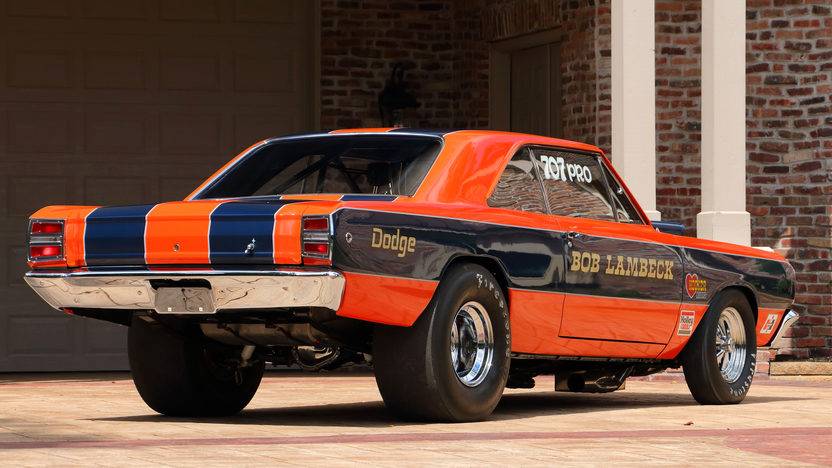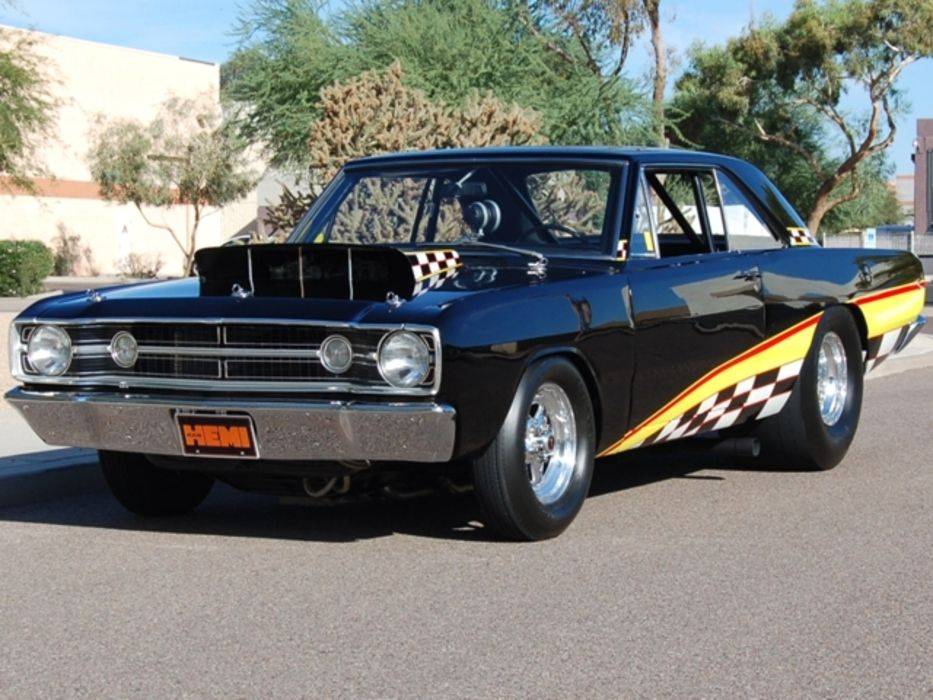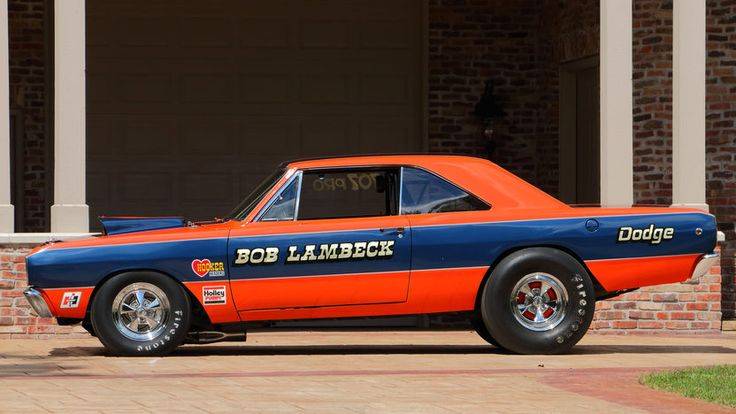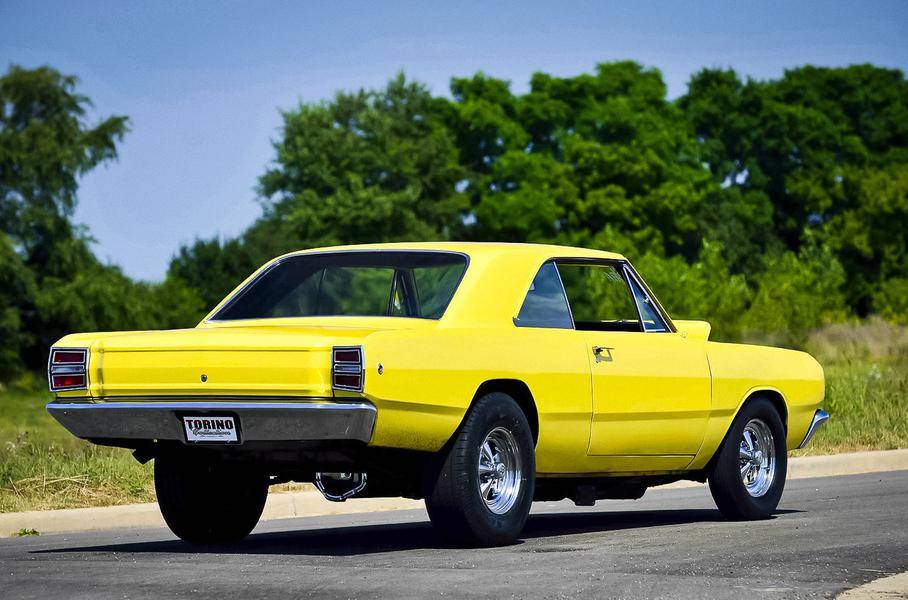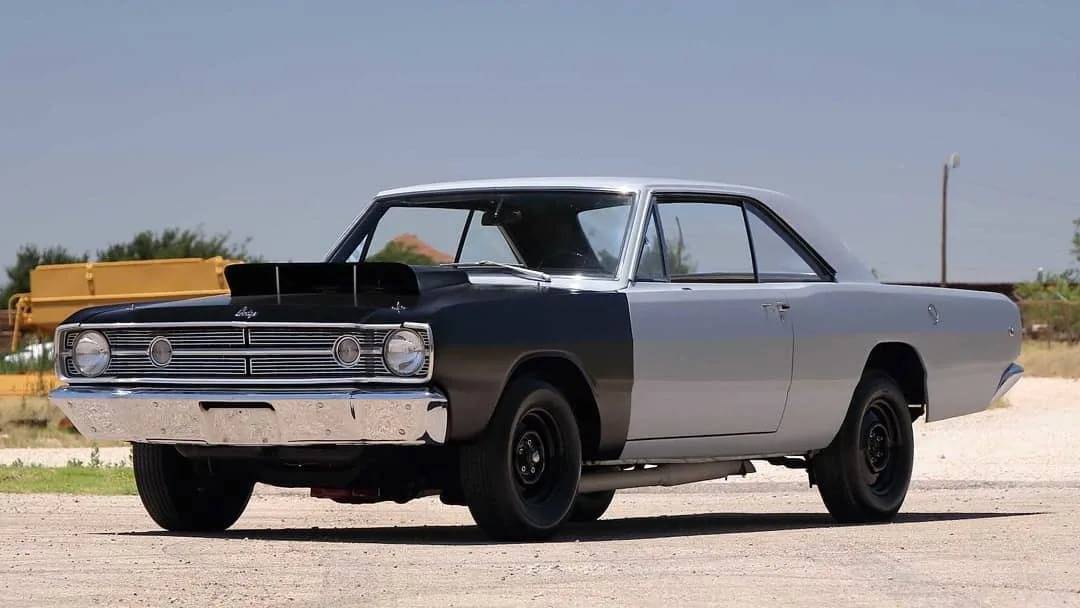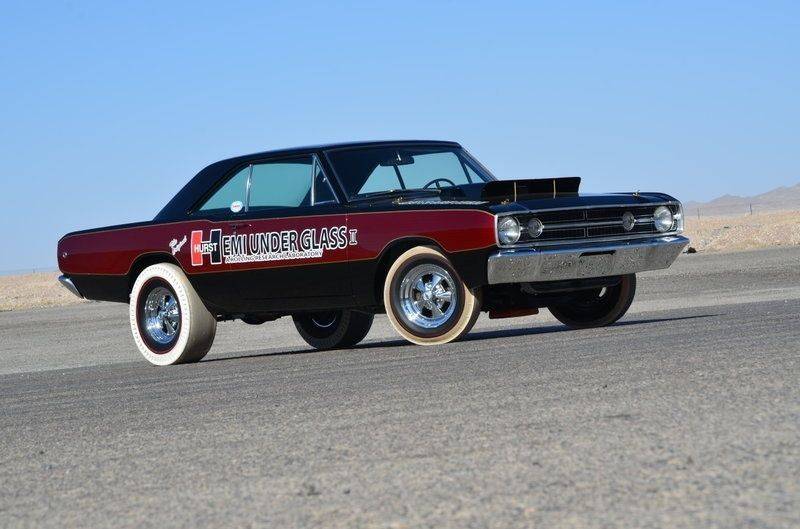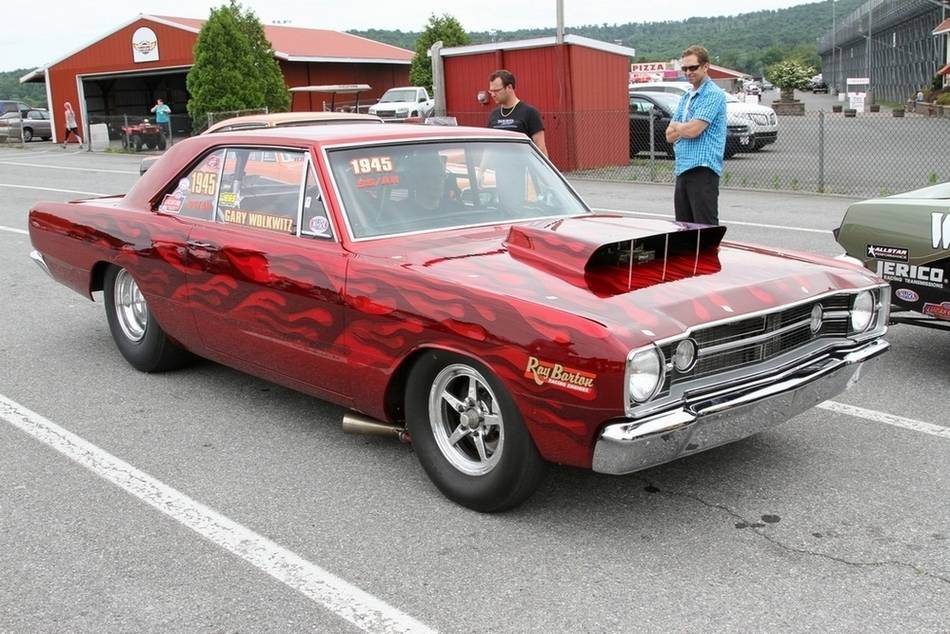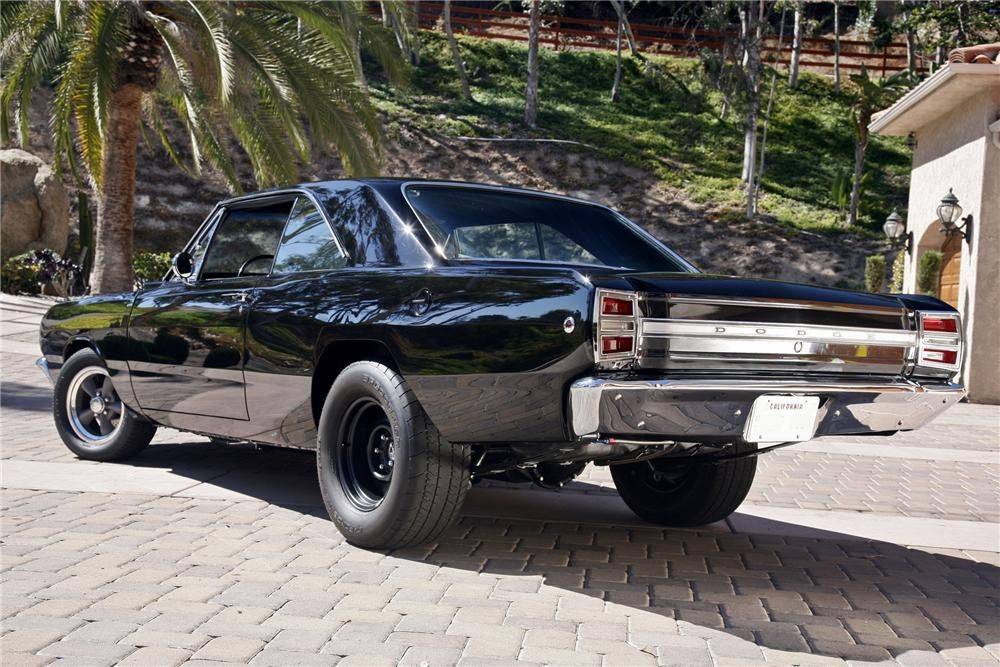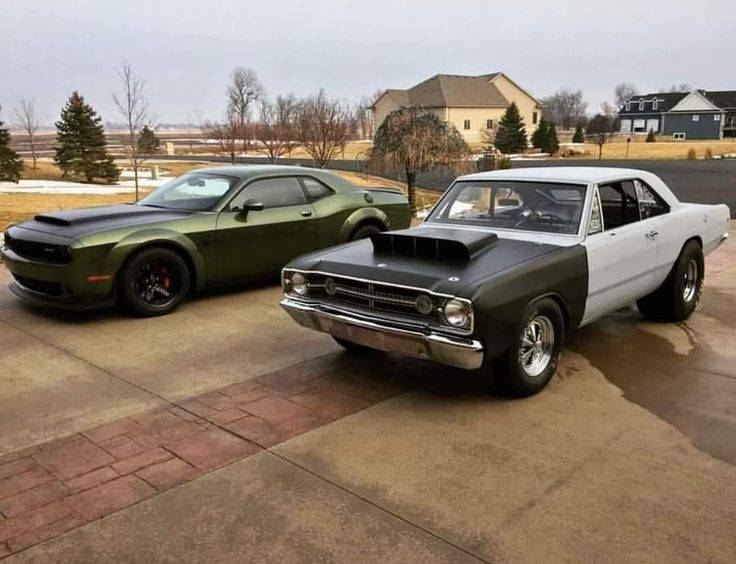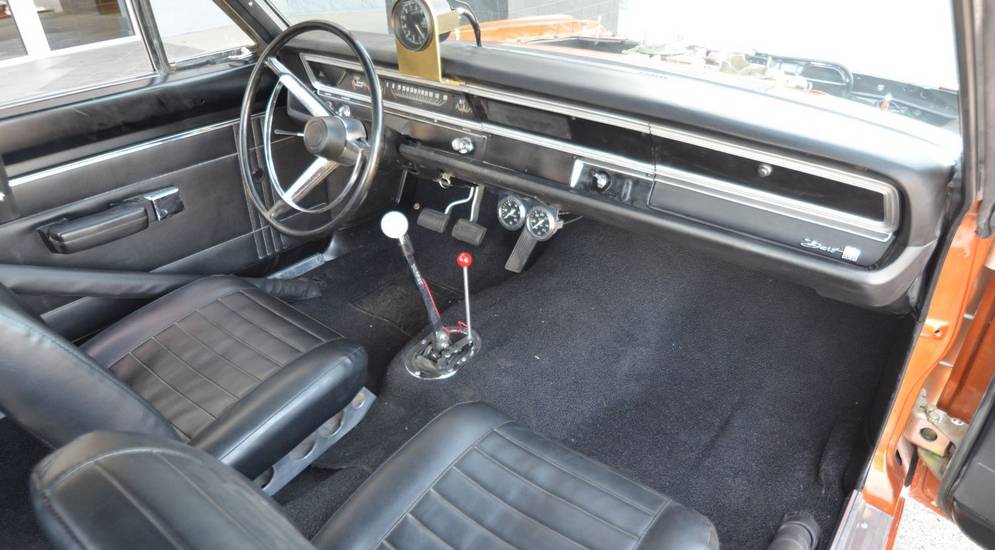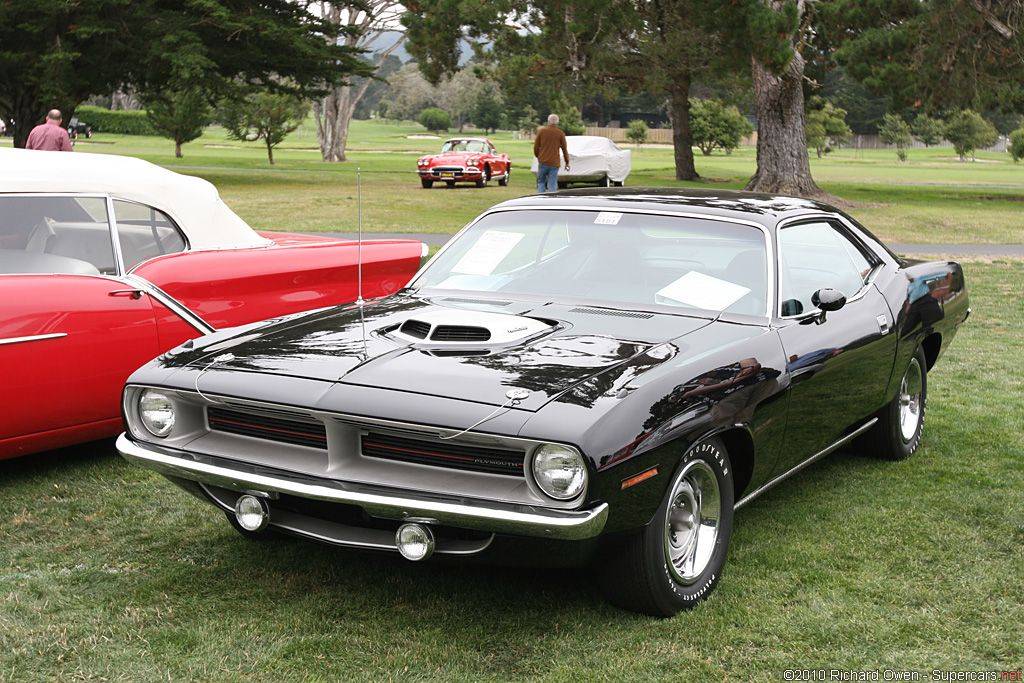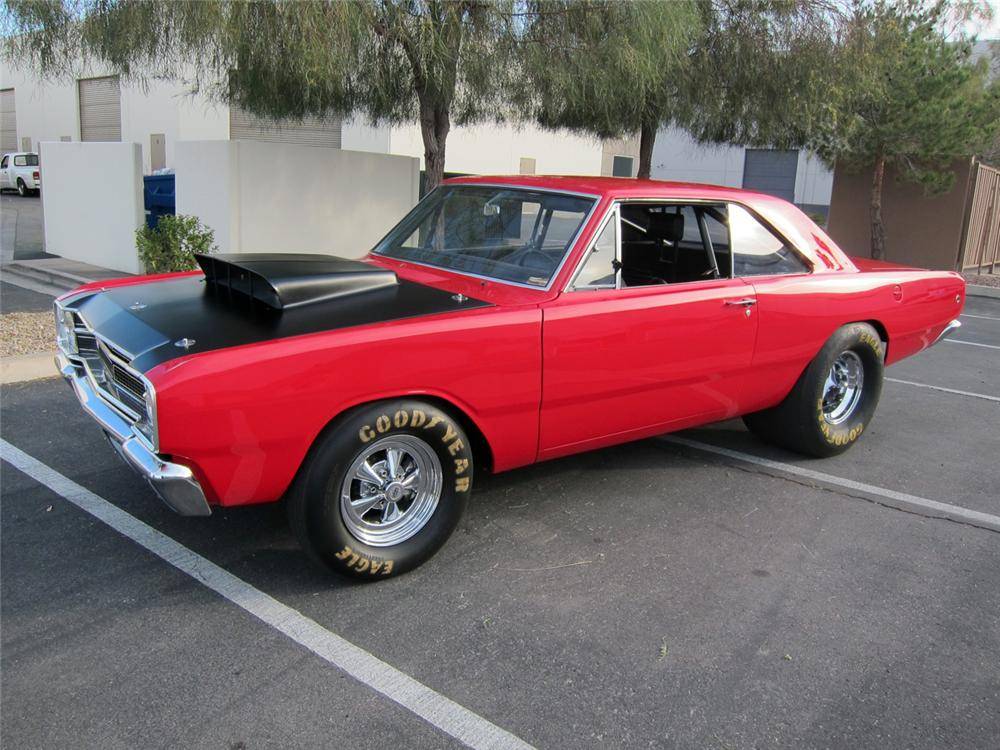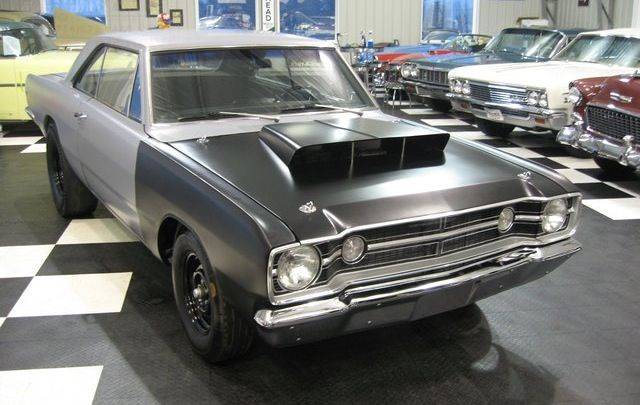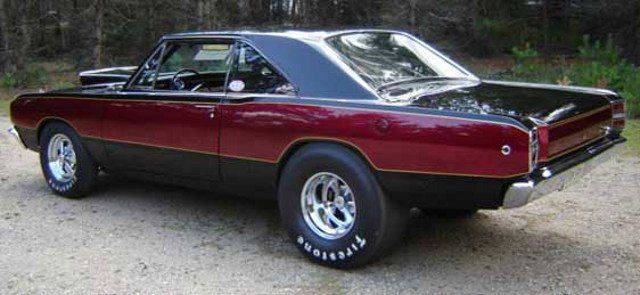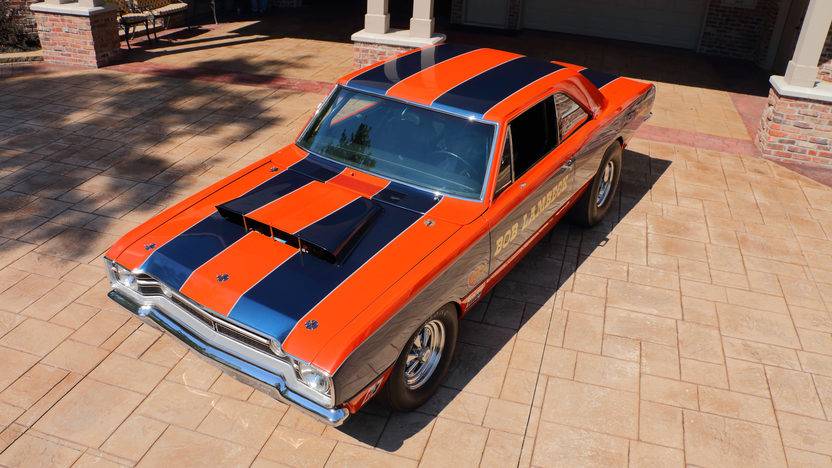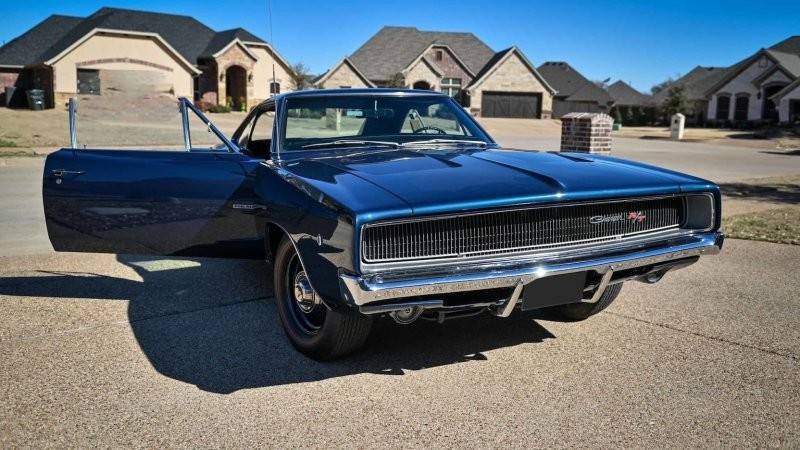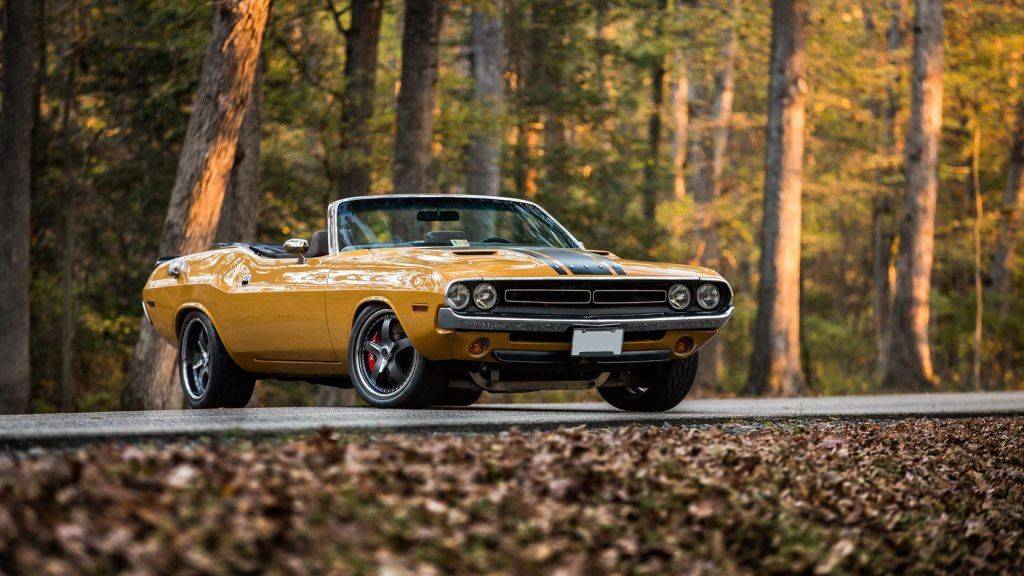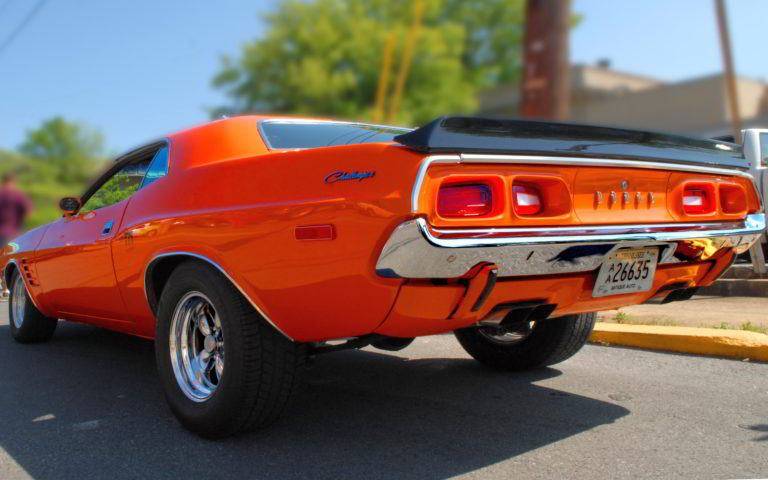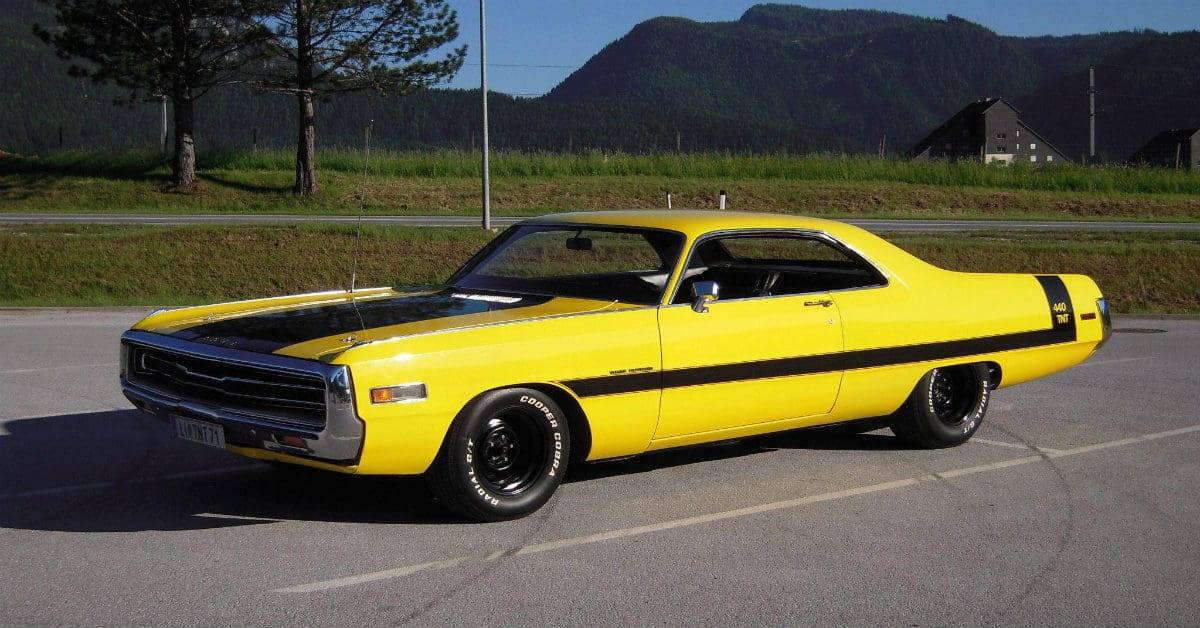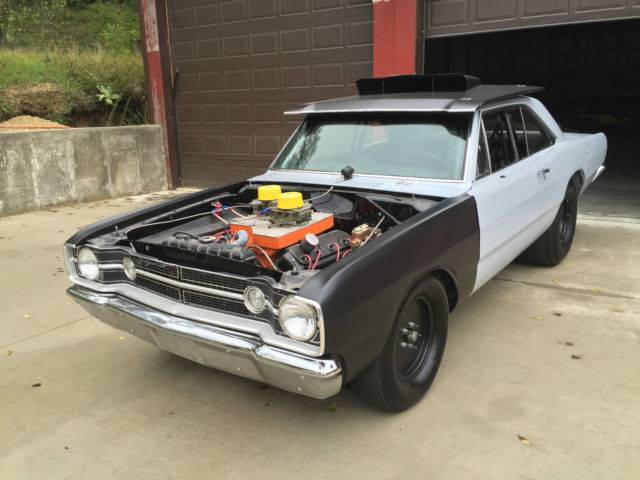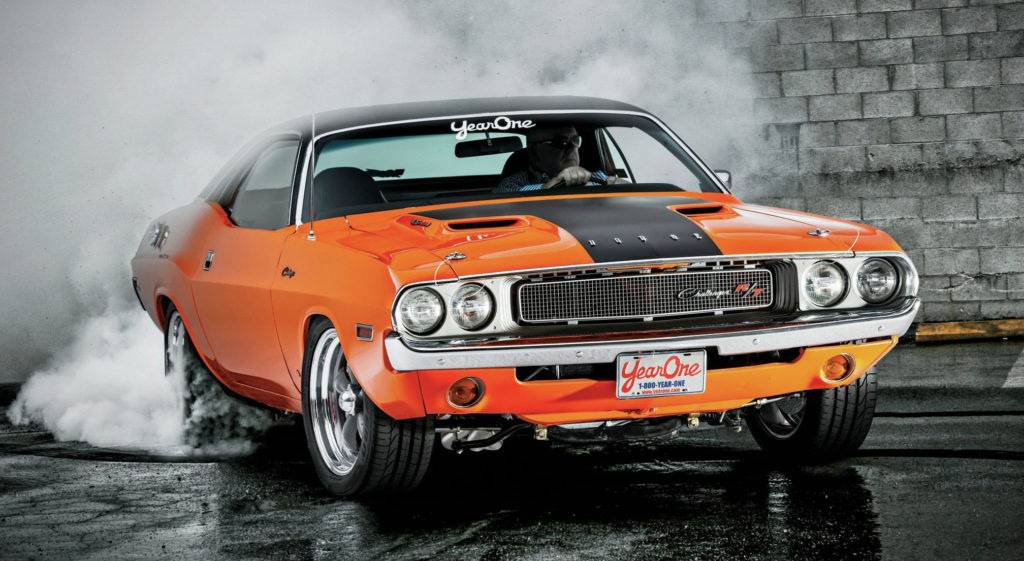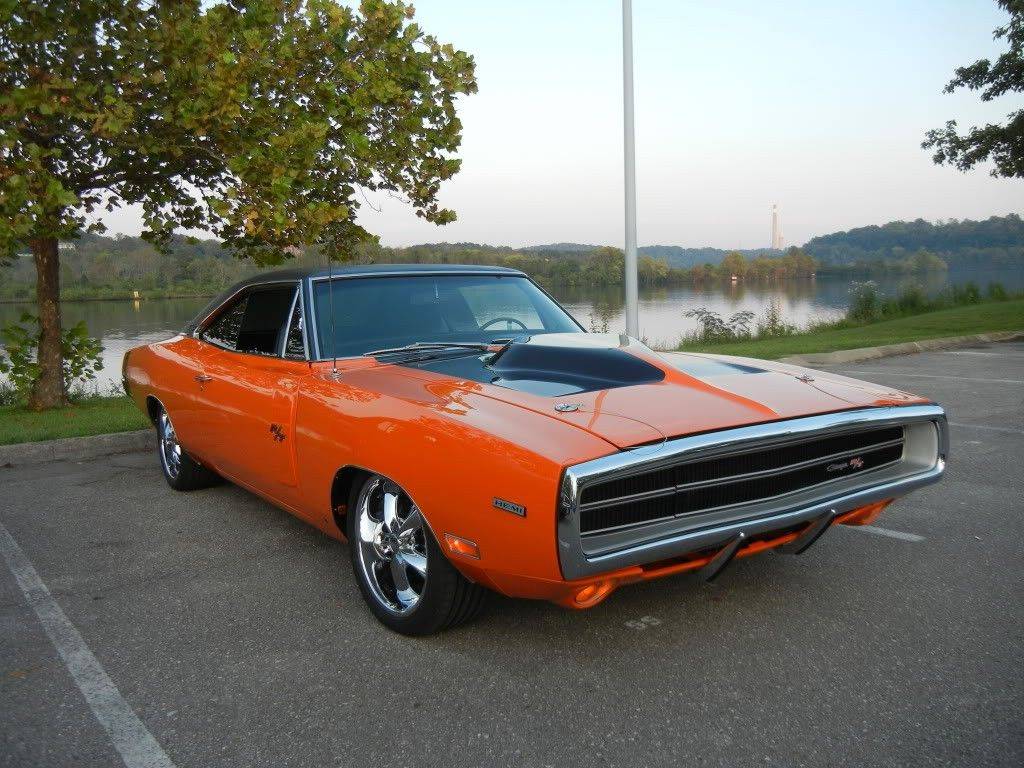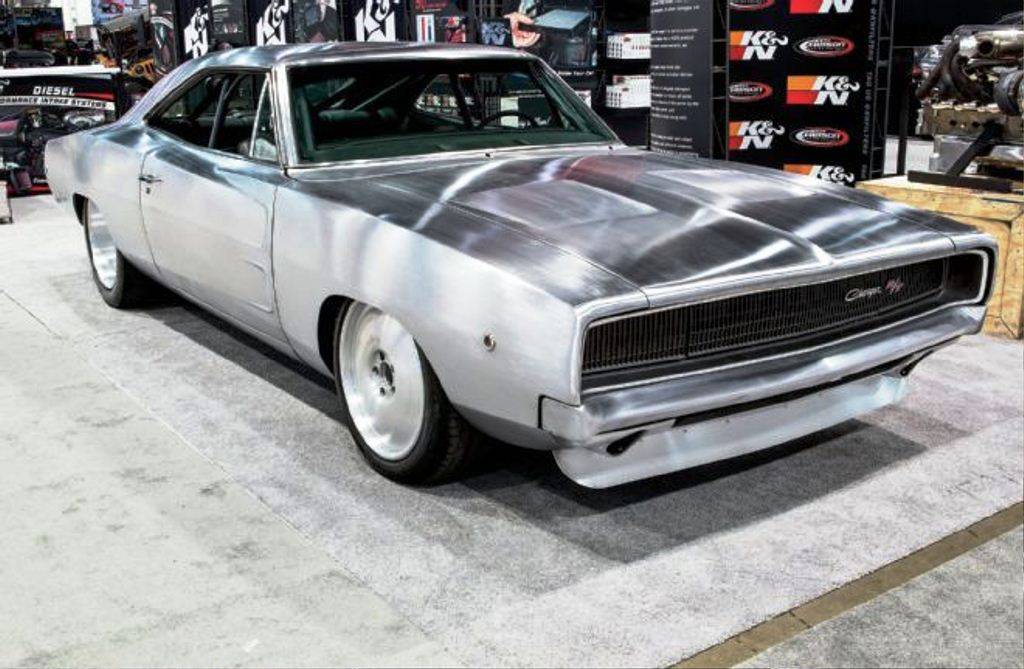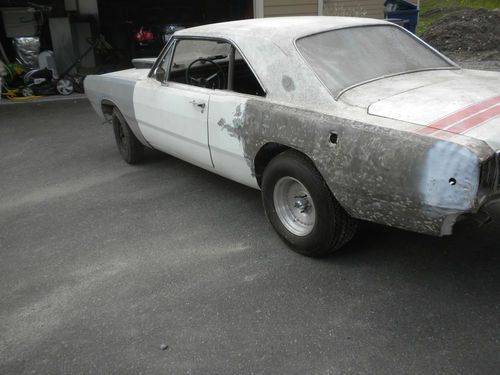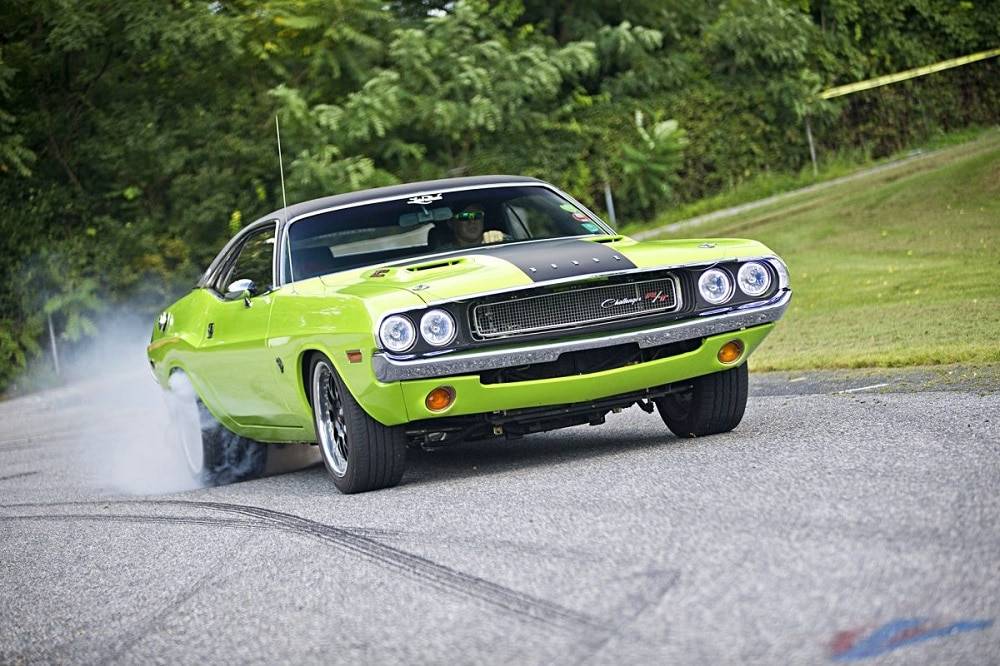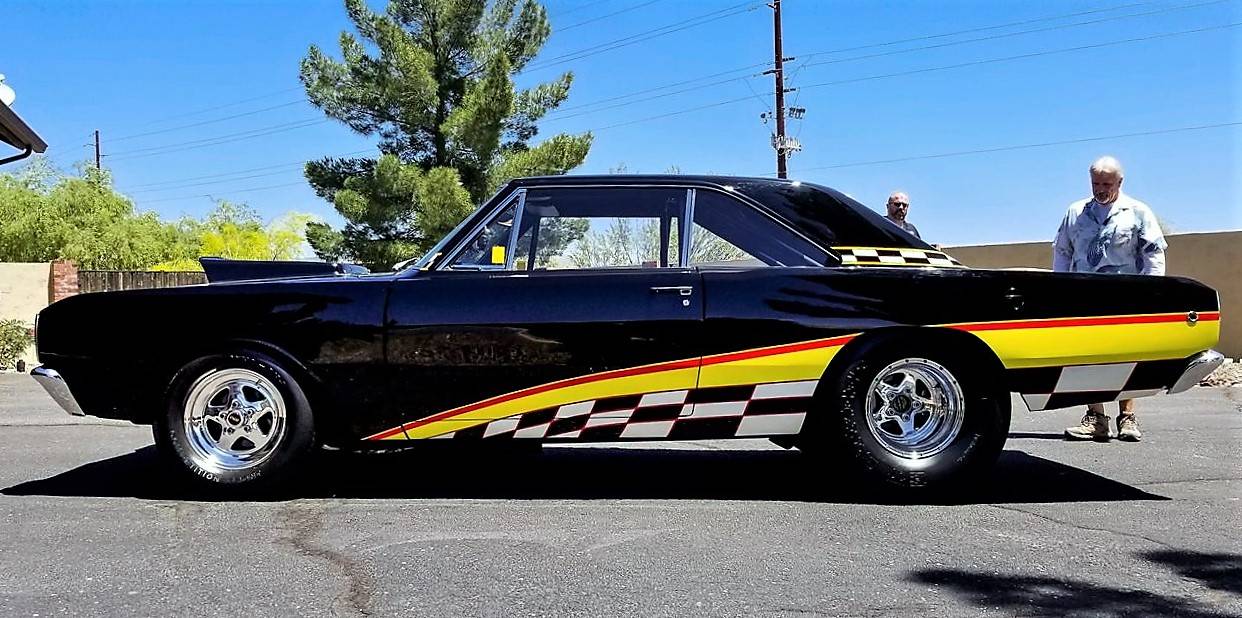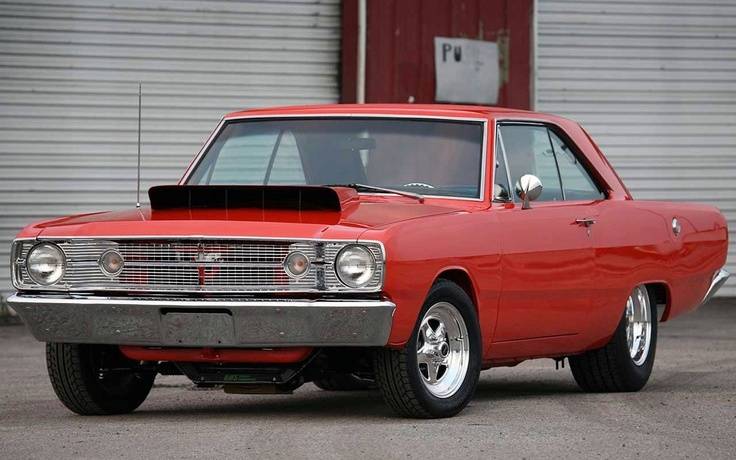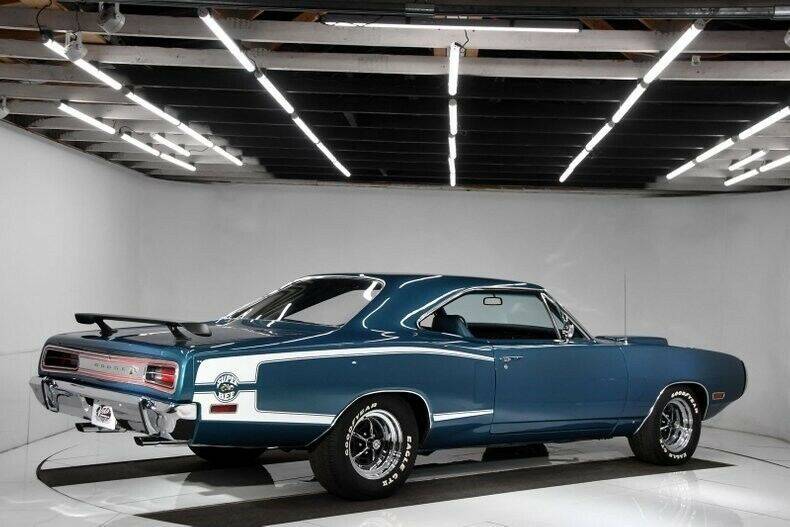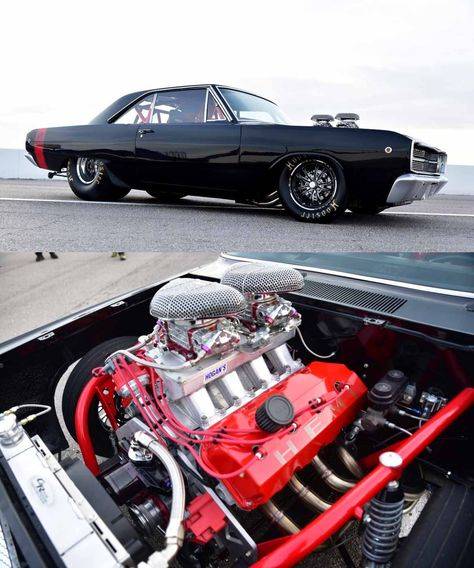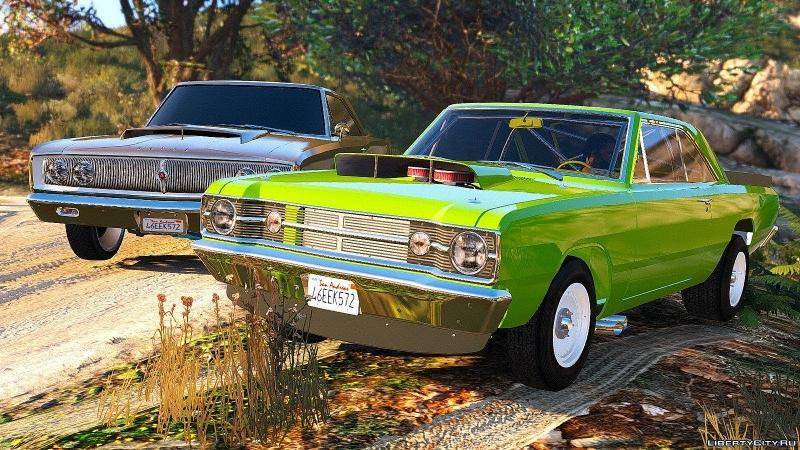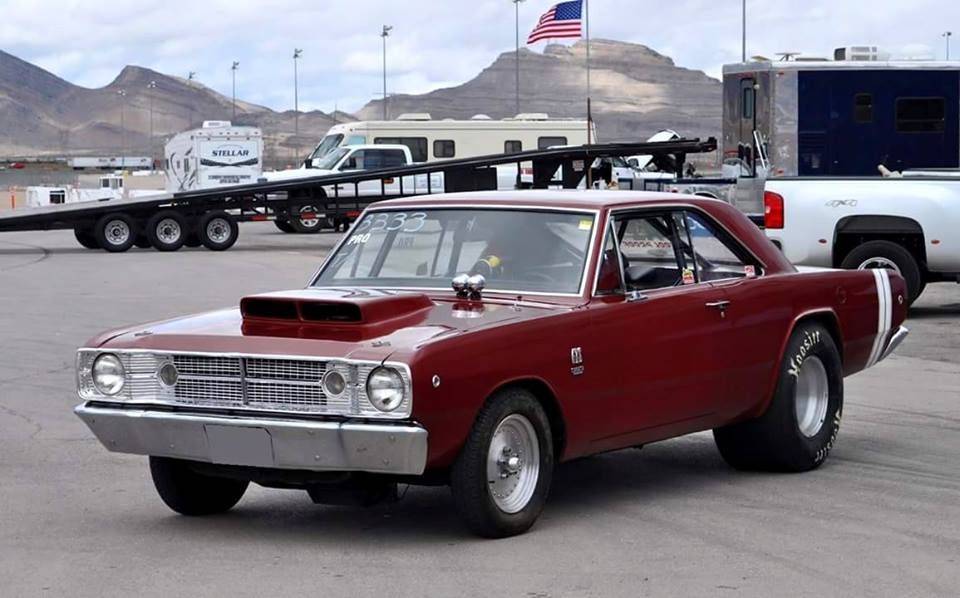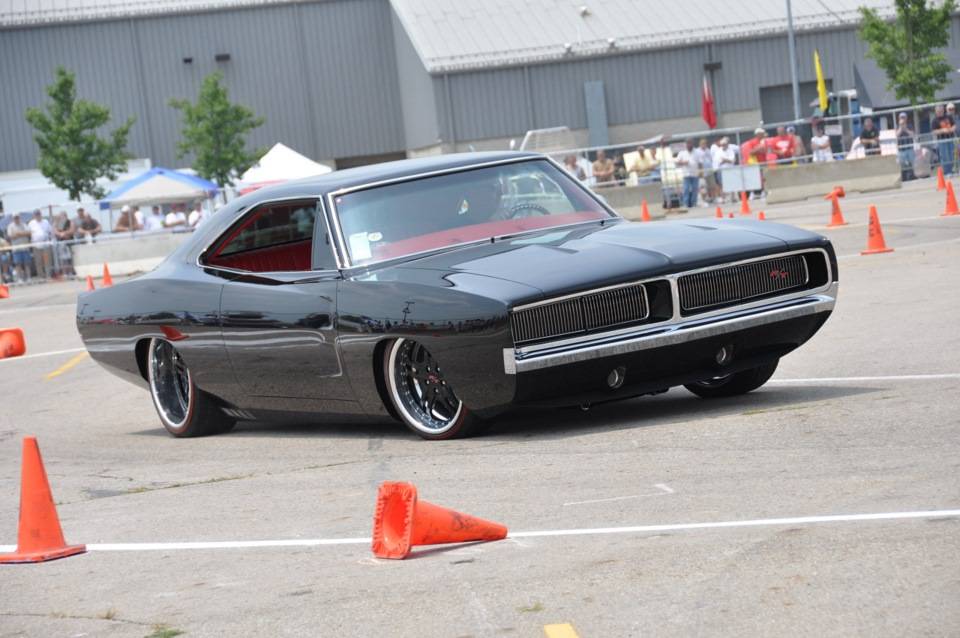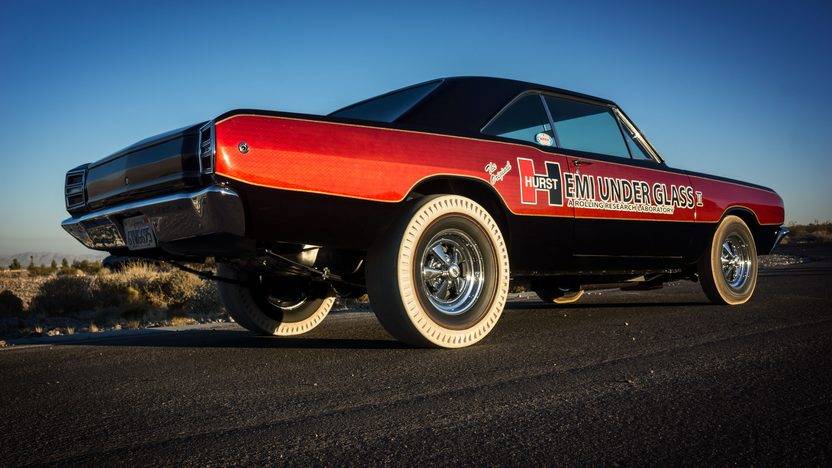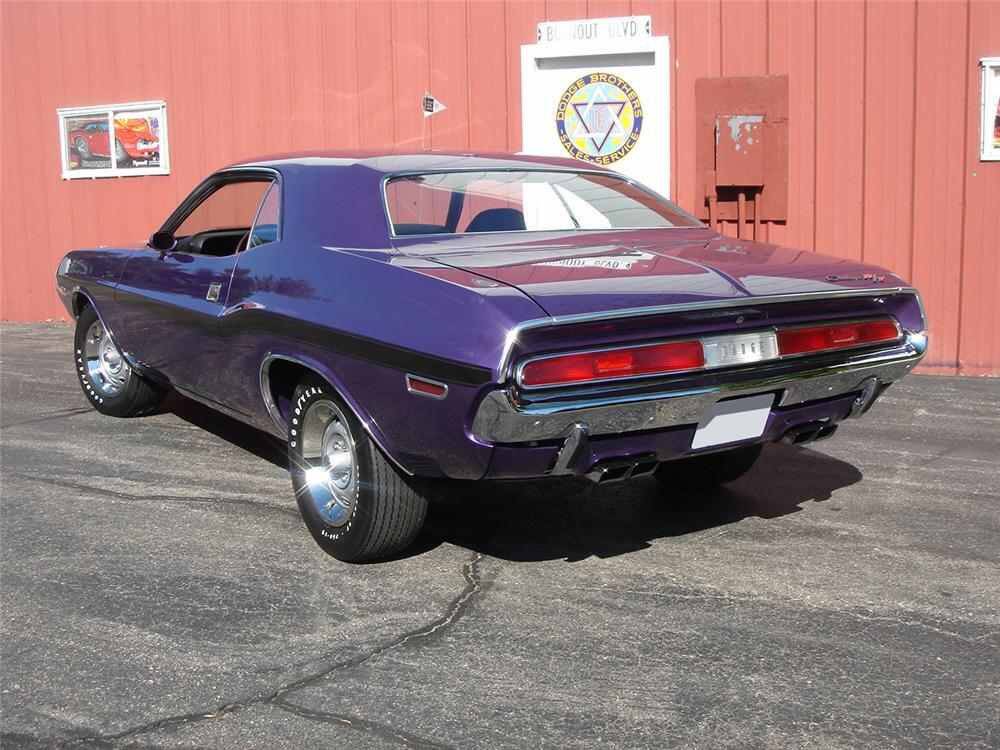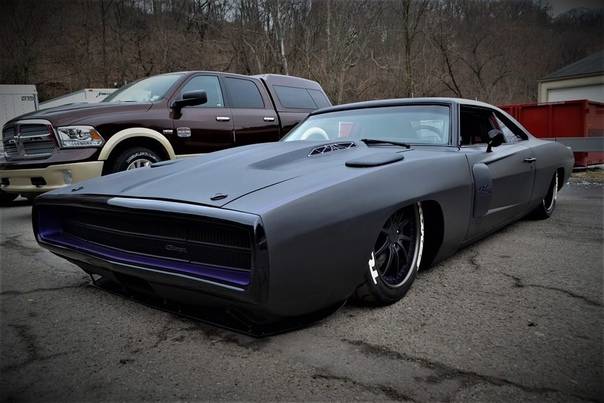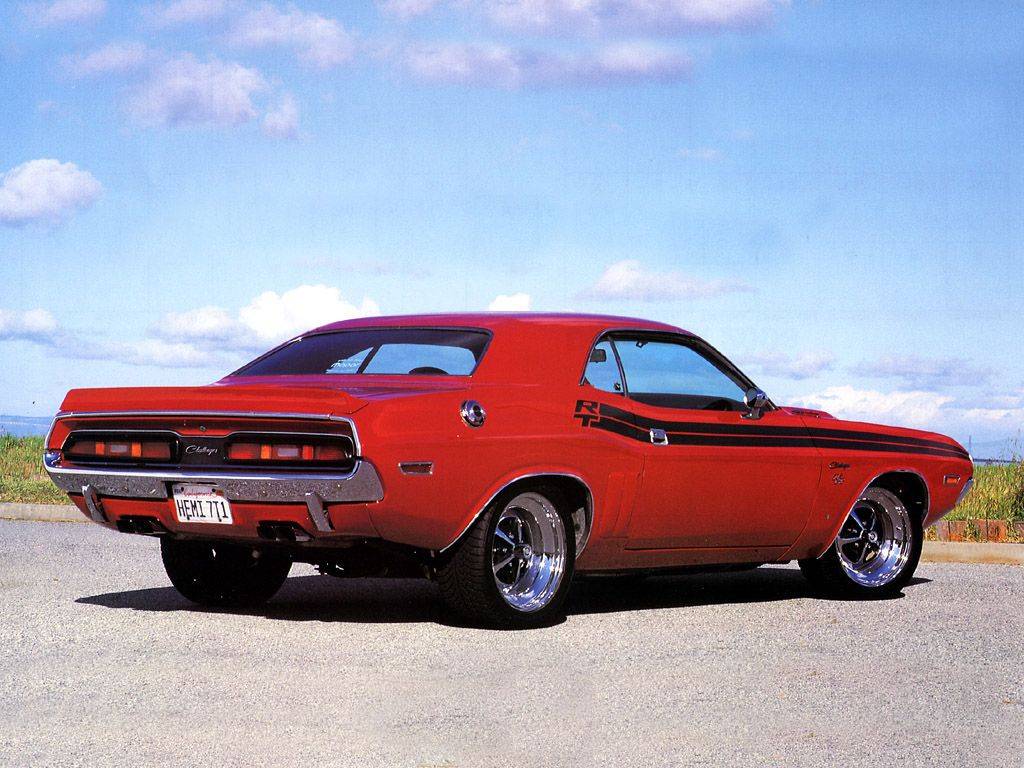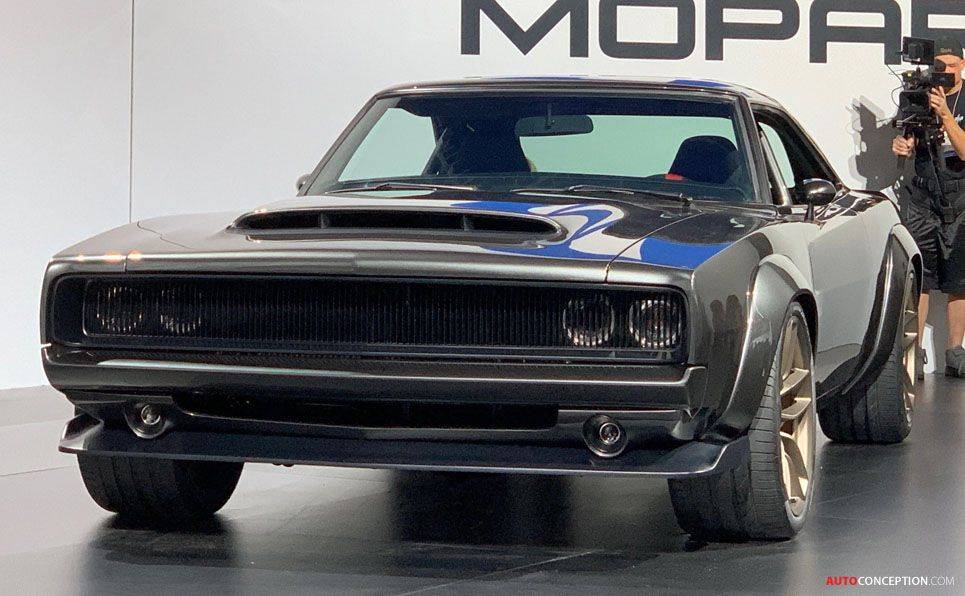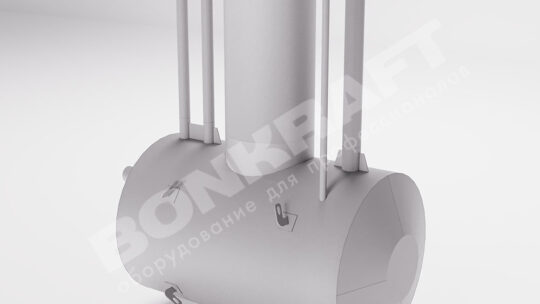Выход на старт

Dodge Charger Daytona преодолел барьер в 200 миль/час. 1970 год
14 сентября 1969 года, Dodge Charger Daytona выходит на старт на новенькой трассе Талладега-500 в Алабаме. Она оказалась самой длинной и самой скоростной за все историю NASCAR. После квалификационных заездов многие гонщики сочли трассу очень опасной, порой машины двигались с куда большей скоростью чем позволяли шины. Были вопросы и к асфальтовому покрытию, местами попадались неровности, в результате чего автомобилем было очень сложно управлять.
Тем не менее даже в таких условиях Daytona смогла разогнаться до 199,466 миль/час (320,94 км/ч). Это рекордный показателю за всю историю чемпионата! Стоит ли говорить, что с такими скоростями заводской Dodge под управлением Ричарда Брикхауса без проблем взял пьедестал. Хотя справедливости ради стоит отметить, что Ford и Mercury предпочли не рисковать и не вывели свои машины на старт.
Dodge Charger 1968-1970
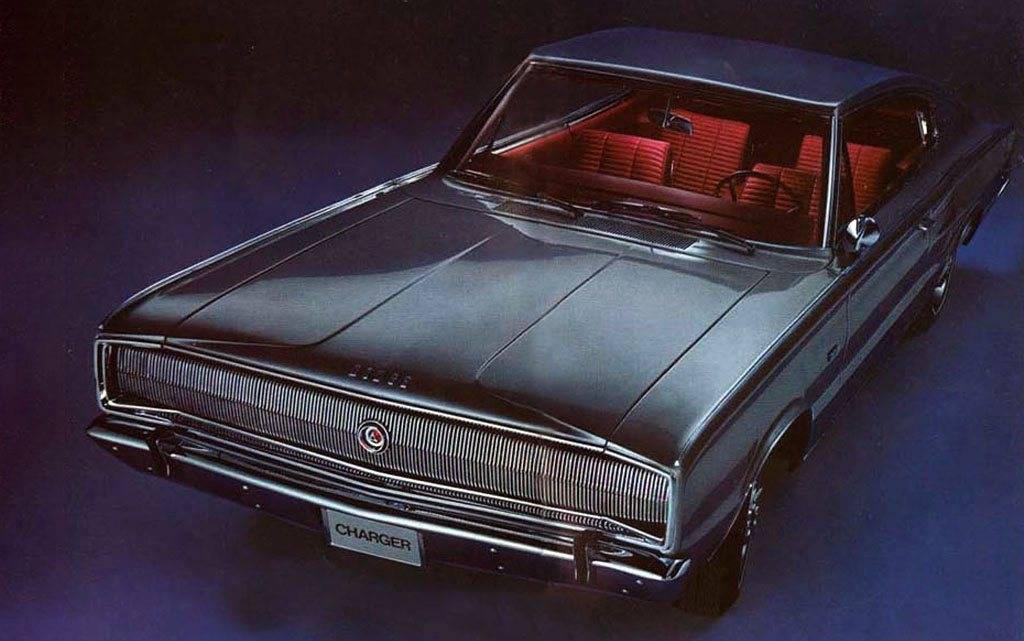
Charger первого поколения
Charger 1966 года использовал платформу Chrysler B-body от Dodge Coronet, а также множество его кузовных элементов. Дизайнеры постарались сделать автомобили максимально непохожими, однако фактически они отличались минимально. Более того, Charger стоил 3100$, что было на 15% дороже Coronet. Частично это компенсировалось тем, что Charger получил высококачественную отделку салона и несколько моторов V8. Тем не менее к 1967 году продажи «маслкара» упали почти в два раза и в Додж решили перезапустить модель.
Великолепный дизайн
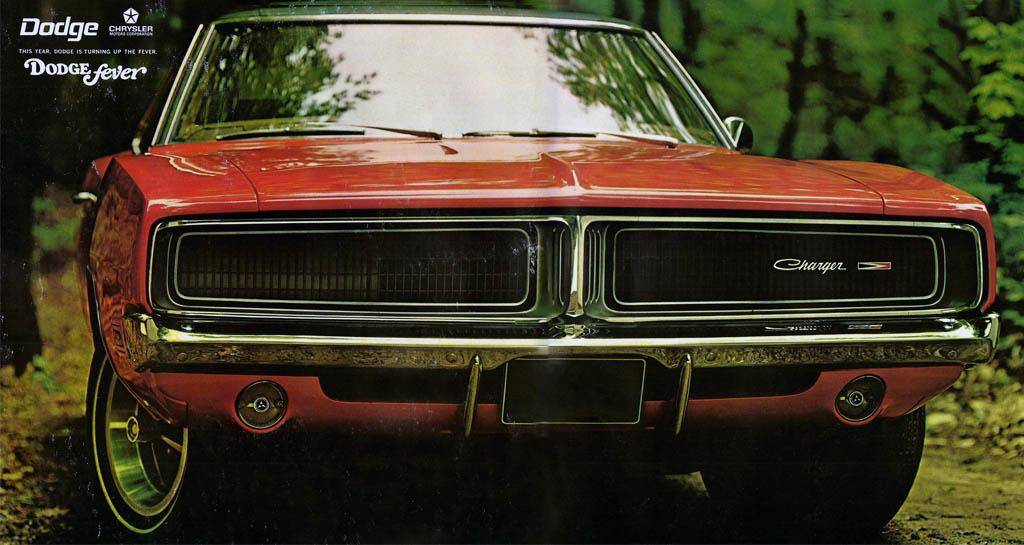
Машины 1969 модельного года можно легко определить по фальшрадиаторной решетке с перемычкой посередине
К вопросу подошли обстоятельно и уже в 1968 году Чарджер второго поколения поступил в производство. Хотя технически автомобиль никак не изменился, его внешний вид был полностью переосмыслен. Над дизайном поработал Ричард Сейс, малоизвестный на то время стилист, которые не имел собственных крупных проектов. Тем не менее дизайн нового Dodge Charger получился чертовски привлекательным.

Автомобиль отличался агрессивным внешним видом с мощными угловатыми крыльями и изогнутой поясной линией в виде бутылки Кока-Колы. Впоследствии этот дизайнерский элемент переняли многие конкуренты, настолько он получился удачным. Кроме того в отличие от модели прошлого поколения, Charger имел кузов типа хардтоп-купе, но с небольшой особенностью. Сейс утопил стекло между задними стойками, визуально увеличив и без того немаленькую корму. Яркой деталью стала откидная крышка бензобака на левом заднем крыле. Которая к слову была очень непрактичной и часто примерзала у владельцев из северных штатов. На что они отшучивались говоря, что будут возить с собой ледоруб, но Чарджер ни на что не променяют.
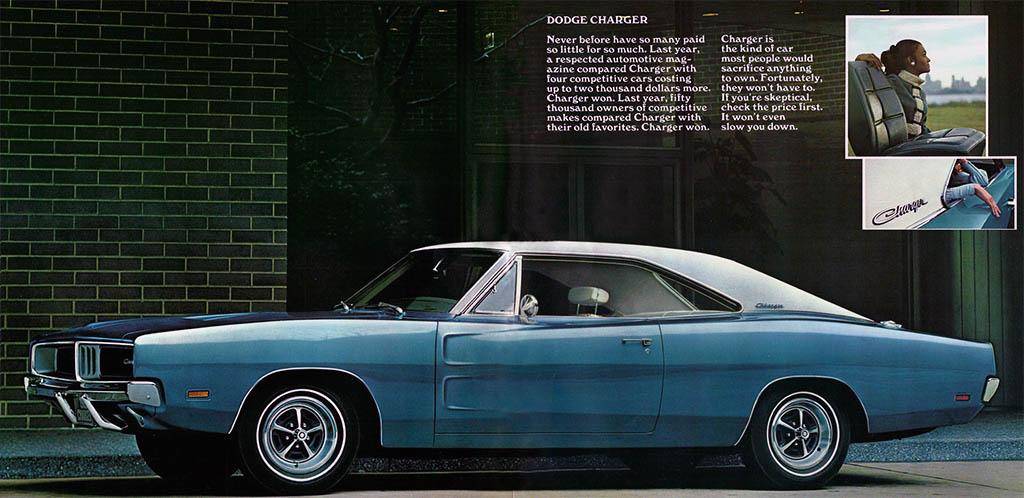
Вообще «маслкар» выглядел брутально, если не сказать жестко, и сильно выделялся в потоке. Образ завершала закрытая фальшардиаторная решетка с хромированной окантовкой и скрытыми фарами. Еще один предмет гордости владельцев.
Мощные моторы
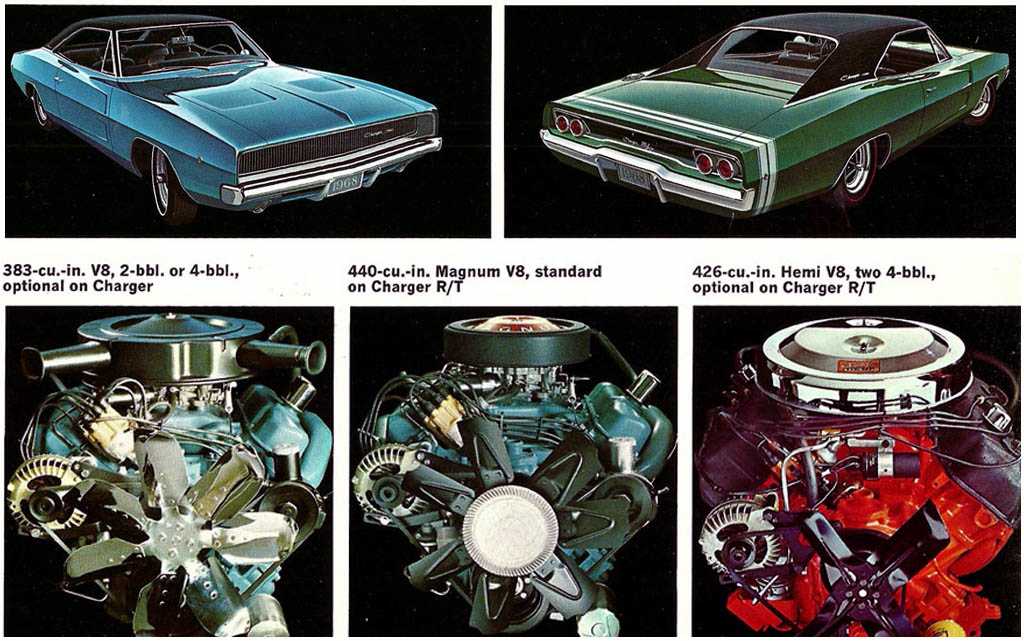
Двигатель 440 Magnum V8 предлагался как базовый для модификации RT
Как и говорилось выше Dodge Charger базировался на той же платформе, что и предшественник. Так что линейка моторов была во многом схожей. От маломощного V8 объемом 318 куб. дюймов (5,2 л) до могучих 440 Magnum (7,2 л) и 426 Hemi (7 л), мощностью 375 л.с. и 425 л.с. соответственно. Последние два были прерогативой специальной модификации R/T (Road/Track). Этим названием в Додж хотели подчеркнуть, что новый Charger хорош не только на дорогах общего пользования, но и на гоночном треке. С мотором Hemi, Charger от 0 до 100 км/ч разгонялся за каких-то 5,3 секунды, а четверть мили преодолевал за 13,5 сек. на выходе разгоняясь до 164 км/ч! Конечно же такие выдающиеся результаты благоприятно повлияли на продажи. Чарджеры раскупали очень активно и за первый год удалось продать 96 тысяч машин из них 17 тысяч в модификации RT.
Dodge Charger 500
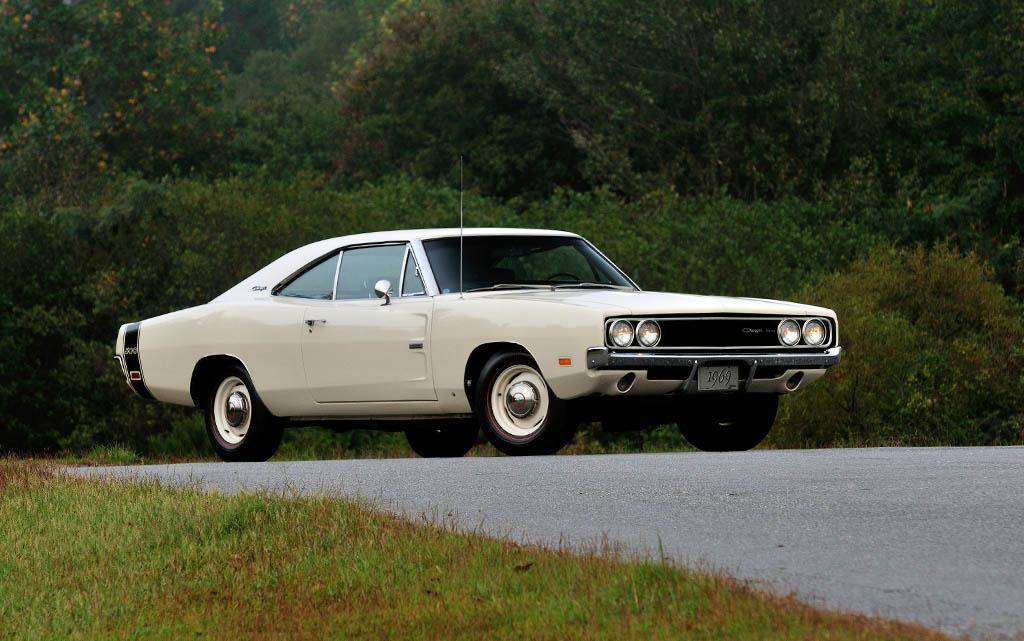
Charger 500 омологированная версия
К концу 60-х противостояние между Ford и Chrysler обострилось до предела. Компании конкурировали не только на автомобильном рынке, но и на гоночных трассах. В конце концов, ничто так не поднимает продажи, как успех в автоспорте. Поэтому когда в сезоне 1968 года на старт гонок NASCAR от Ford вышли мощные и очень быстрые Ford Torino и Mercury Cyclones, у Крайслер начались серьезные проблемы.
Нет, Dodge Charger второго поколения был отличным автомобилем. Но для того чтобы на равных бороться с конкурентами ему не хватало скорости. Инженеры посчитали, чтобы нивелировать отставание, необходимо нарастить мощность мотора Hemi на 90 л.с. Однако такая форсировка, потребовала бы серьезной и дорогой переделки двигателя, поэтому от нее отказались и решили сосредоточиться на аэродинамике.
Первым делом инженеры сменили стандартную решетку радиатора, на открытую от Dodge Coronet, а заднее стекло выполнили заподлицо со стойками. Машину назвали Dodge Charger 500 и в конце сезона 68-года она вышла на старт. Чардждер поехал немного быстрее, но даже с такими переделками, он не смог составить достойную конкуренцию машинам от Форд. Стало понятно, что к вопросу улучшения аэродинамики требуется подойти более обстоятельно.
Synopsis
The 1968 Dart Hemi Super Stock, codenamed L023, is a drag racing-prepared model by Hurst Performance of which 50 models were built.
Drivetrain
The Dart’s 426 ci (7 litres) Hemi V8 engine, which would not have fit in the engine bay without some modifications to the body and strut towers, comes with 425 hp (317 kW) and 490 ft·lb (664 N·m). Although its engine specifications remain unchanged from other cars with the 426 Hemi V8, the Dart utilises a four-speed close-ratio transmission and has the advantage of having less weight.
Platform
It uses a stripped-out platform using various fiberglass applications, plexiglass windows and doors with thin paint that result in a weight of 3020 lb (1370 kg), making it both the lightest 1960s Dodge and one of the lightest classic muscle cars in the Forza series. It also has a front weight percentage of 54%, an impressive value for muscle cars of its era.
Dodge Charger Daytona 1969
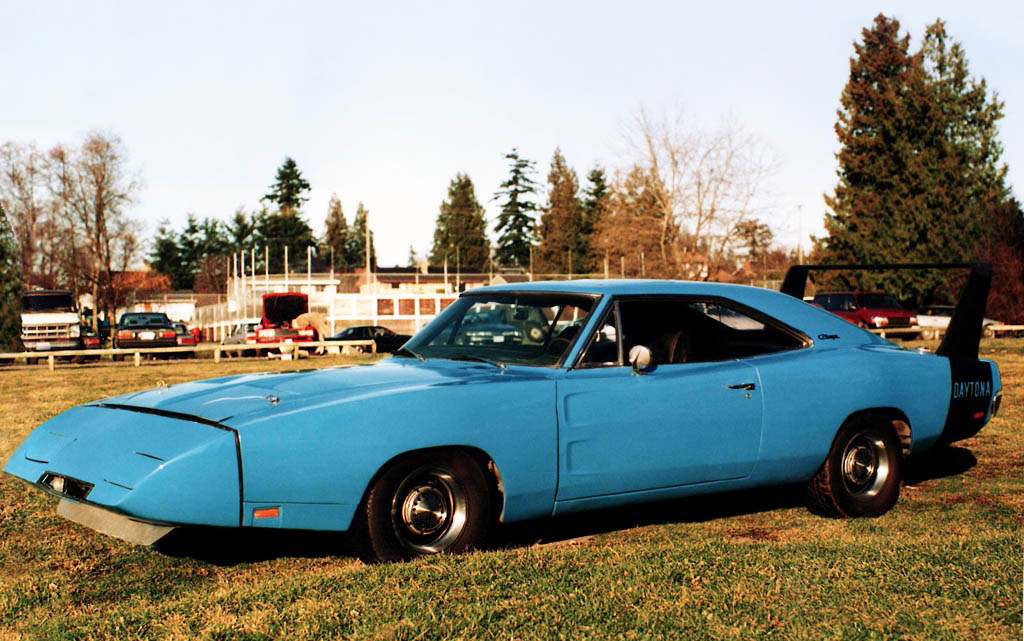
В свое время Daytona считалась не самым красивым автомобилем. А сегодня стоит сотни тысяч долларов
Специалисты Chrysler не привыкли размениваться по мелочам, поэтому решили обратиться к инженеру-ракетостроителю Джону Поинтеру. Он работал в Chrysler Corporation Missile Division, которая помогала NASA в работе над лунной программой.
В качестве основы был взят Dodge Charger 500, к которому Поинтер разработал переднюю «маску» обтекатель. После экспериментов с ее размером и углом наклона, машину продули в аэродинамической трубе и получили потрясающий результат. Cx составлял всего лишь 0,28. Для конца 60-х выдающийся результат.
После первых тестовых заездов, испытатели выявили недостаточную прижимную силу в задней части машины. В результате в дополнение к обтекателю, Поинтер сзади разместил антикрыло высотой 580 мм. Кстати именно поэтому Dodge Charger Daytona и его побратим Plymouth Superbird, получили прозвище «Winged Warriors» (Крылатые воины).
В июле 1969 году, прототип был испытан на полигоне, где подтвердил свои высокие характеристики. Даже с немного дефорсированным мотором Dodge Charger Daytona смог разогнаться до 330 км/ч и при этом был невероятно устойчив на дороге. Стало понятно, что Chrysler наконец-то получил грозное оружие.
Performance
Equipped with a close-ratio transmission in stock form, the Dart Hemi Super Stock can complete 0 to 60 mph (97 km/h) in only 3.6 seconds and 0 to 100 mph (161 km/h) in 9.3 seconds, making it one of the fastest accelerating muscle cars to appear in the Forza series. Its acceleration comes at the expense of top speed as it already tops out at 127 mph (204 km/h). Handling-wise, the Dart is up to par with most classic muscle cars.
With straight-line performance being the car’s strong suit, the Dart can be upgraded for maximum speed when modified with a Race Transmission along with a powerful engine swap such as the 6.5L V12. To maximize acceleration, players can change to an AWD drivetrain, although this will limit top speed unless gearing is changed.
In terms of drag racing performance in Forza Horizon 3, the Dart is the fastest S2 class car in drag races.
Upgrade Map
Insert upgrade values at ??. — means that that value doesn’t exist.
Restore
| Price | |||
|---|---|---|---|
| Stage | Weight | Cash | Gold |
| 1 | -19 | 41505 | — |
| Description | Initial rust removal. Spare wheel removed. Improves acceleration. | ||
| 2 | -48 | 83008 | 130 |
| Description | Bodywork filled and sanded. Internal weight stripped. Improves launch speed. | ||
| 3 | -76 | 130416 | 172 |
| Description | Primer and base paint coat applied. Further internal weight stripped. | ||
| 4 | -29 | $275322 | 257 |
| Description | Final paint coat applied and lacquered. Engine bay weight removal. | ||
| 5 | -38 | 371657 | 352 |
| Description | Machine polished and waxed. Body panel interiors stripped. | ||
| Stage 5 Upgrade Stats | |||
| Weight | |||
| Cost to Max Out Restore | |||
| Least Gold | Most Gold | ||
| Cash | Cash | Gold | |
| $?????? | $?????? | + | ??? |
Tires & Rims
| Price | |||
|---|---|---|---|
| Stage | Grip | Cash | Gold |
| 1 | +45 | $27419 | — |
| Description | Surface wheel rust removed. Premium road tires fitted reducing wheelspin. | ||
| 2 | +115 | $54836 | 117 |
| Description | Wheels scoured. Sports tires fitted. Improving wheels reducing wheelspin. | ||
| 3 | +180 | $86155 | 155 |
| Description | Wheels sand blasted. Soft compound sports tires fitted reducing wheelspin | ||
| 4 | +70 | 181882 | 230 |
| Description | Wheels powder-coated and grooved slick tires fitted. Improving tires reducing wheelspin. | ||
| 5 | +90 | ||
| Description | Wheels lacquered and polished. Branded slicks fitted reducing wheelspin. | ||
| Stage 5 Upgrade Stats | |||
| Grip | +??? | ||
| Cost to Max Out Tires & Rims | |||
| Least Gold | Most Gold | ||
| Cash | Cash | Gold | |
| $?????? | $?????? | + | ???? |
Gearbox
| Price | |||
|---|---|---|---|
| Stage | Gearbox | Cash | Gold |
| 1 | -20 | 53148 | — |
| Description | Factory gearbox rebuit. Quickens gear changes and revs faster. | ||
| 2 | -20 | 106294 | 98 |
| Description | Uprated clutch and lightened flywheel. Quickens gear changes and revs faster. | ||
| 3 | -20 | 167001 | 129 |
| Description | Triple plate clutch that quickens gear changes. | ||
| 4 | -20 | 352557 | 189 |
| Description | Quickshift gear levers fitted for efficient changes. | ||
| 5 | -20 | 475918 | 259 |
| Description | Electronic gear change assistance. Improves gear change times. | ||
| Stage 5 Upgrade Stats | |||
| Gearbox | -100 | ||
| Cost to Max Out Gearbox | |||
| Least Gold | Most Gold | ||
| Cash | Cash | Gold | |
| $?????? | $?????? | + | ??? |
Engine
| Price | |||
|---|---|---|---|
| Stage | Power | Cash | Gold |
| 1 | +19 | $68490 | — |
| Description | New spark plugs, HT leads, high performance coil and distributor. Increases BHP. | ||
| 2 | +16 | $136976 | 130 |
| Description | High performance camshaft. Increases BHP. | ||
| 3 | +16 | $215208 | 172 |
| Description | Ported and polished cylinder head. Increases BHP. | ||
| 4 | +15 | $454326 | 351 |
| Description | Forged bottom end with high compression pistons. Increases rev range and BHP. | ||
| 5 | +35 | $613296 | 481 |
| Description | Fully blueprinted engine. Increases BHP. | ||
| Stage 5 Upgrade Stats | |||
| Power | +?? | ||
| Cost to Max Out Engine | |||
| Least Gold | Most Gold | ||
| Cash | Cash | Gold | |
| $?????? | $?????? | + | ???? |
Carburetor
| Price | |||
|---|---|---|---|
| Stage | Power | Cash | Gold |
| 1 | +15 | $43514 | — |
| Description | 4 Barrel carburetor and performance manifold increases BHP. | ||
| 2 | +15 | $87026 | 65 |
| Description | Re-jetting of carburetor for improved fuel flow. Increases BHP. | ||
| 3 | +19 | $136729 | 86 |
| Description | Twin carburetors. Increases fuel delivery and BHP. | ||
| 4 | +51 | $288648 | 122 |
| Description | Carburetors port matched to the inlet manifold. Increases BHP. | ||
| 5 | +?? | $389647 | 167 |
| Description | Carburetors replaced with individual throttle bodies. Increases BHP. | ||
| Stage 5 Upgrade Stats | |||
| Power | +?? | ||
| Cost to Max Out Carburetors | |||
| Least Gold | Most Gold | ||
| Cash | Cash | Gold | |
| $?????? | $?????? | + | ???? |
Exhaust
| Price | |||
|---|---|---|---|
| Stage | Power | Cash | Gold |
| 1 | +12 | $11894 | — |
| Description | Stainless steel tubular exhaust manifold. Increases BHP. | ||
| 2 | +13 | $23788 | 33 |
| Description | Big bore custom made stainless exhaust system. Increases BHP. | ||
| 3 | +13 | $37374 | 43 |
| Description | Stainless steel exhaust. Increases BHP. | ||
| 4 | +40 | $78901 | 54 |
| Description | Silencers removed for a free-flowing exhaust. Increases BHP. | ||
| 5 | +?? | $106510 | 75 |
| Description | 4 in to 1 exhaust manifold for increased top end power. | ||
| Stage 5 Upgrade Stats | |||
| Power | +?? | ||
| Cost to Max Out Exhaust | |||
| Least Gold | Most Gold | ||
| Cash | Cash | Gold | |
| $?????? | $?????? | + | ???? |
Nitrous
| Price | |||
|---|---|---|---|
| Stage | Upgrade | Cash | Gold |
| 1 | 2s Boost | $27990 | — |
| Description | Dry nitrous system, trigger for a 2-second speed boost. | ||
| 2 | 3s Boost | $55978 | 78 |
| Description | Higher capacity bottle. Increases boost duration. | ||
| 3 | 50HP | $87948 | 103 |
| Description | Wet system with throttle body plates with 50HP jets. | ||
| 4 | 75HP | $185668 | 149 |
| Description | Direct port delivery for improved power with 75HP jets, | ||
| 5 | 100HP | $250634 | 204 |
| Description | 100HP jets and nitrous bottle heater installed for optimum pressure. | ||
| Stage 5 Upgrade Stats | |||
| Nitrous | 3s of 100HP boost | ||
| Cost to Max Out Nitrous | |||
| Least Gold | Most Gold | ||
| Cash | Cash | Gold | |
| $?????? | $?????? | + | ???? |
Variants
Horizon Edition
The Horizon Edition is an upgraded variant in Forza Horizon 3 featuring an S1 900 upgrade preset and a credits boost. Its appearance was altered with Race Aero upgrades, a blower hood, a supercharged 6.2L V8 (415 hp) engine swap, and aftermarket wheels.
It was only unlockable via various .
Forza Edition
The Forza Edition is a Forza Motorsport 7 rendition of the Horizon Edition featuring homologated performance, as well as a 20% credits boost and an additional 20% credits boost for hitting 150 mph (241 km/h). Due to the use of homologated performance, the 6.2L V8 engine swap from the Horizon Edition is not equipped.
It can be won upon unlocking the .
Dodge Dart History 1960-1962
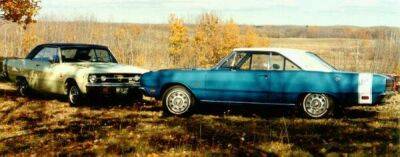
Introduction: The Dart was Dodge’s entry in the growing compact market. Introduced in 1960, the first generation Dodge Dart was actually just a small fullsize car. It was “reborn” in 1963 as a true compact. The Dart lineup would continue to evolve, and included Demon and Swinger models as well as the Dodge Sport and the mighty Dart GTS.
1960 Dodge Dart
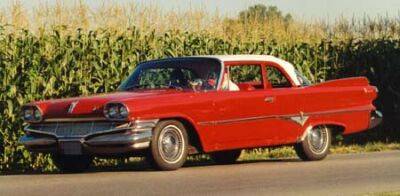
Comments: The Dodge Dart name first appeared as a radically aerodynamic showcar in 1956. It returned four years later as a new downsized regular production vehicle. Featuring utilized body construction, and riding on a 118 inch wheelbase, it was four inches shorter than Dodge’s Polara flagship and thus was Dodge’s “compact” fullsize model. The Dart was available as three models: Seneca, Pioneer, and Phoenix. Engine choices included a 318 cid V8 with either a two or four barrel carb, or a 361 cid V8 with 310 bhp. All three models were available with Dodge’s D500 performance option which included the 361 cid V8 with a new ram-induction setup which featured twin four-barrels on long, individual-runner intake manifolds which had a supercharger effect. This ram setup was also used on the larger 383 cid V8s used in Polara models, and a few Ram 383s found their way into the smaller Dart.
Production:Engines: 318 V8 (2bbl) 230 bhp @ 4400 rpm, 340 lb-ft @ 2400 rpm. 318 V8 (4bbl) 255 bhp @ 4400 rpm, 345 lb-ft @ 2800 rpm. 361 V8 310 bhp @ 4800 rpm, 435 lb-ft @ 2800 rpm.Performance: 361/310: 0-60 mph in 8 seconds.
1961 Dodge Dart
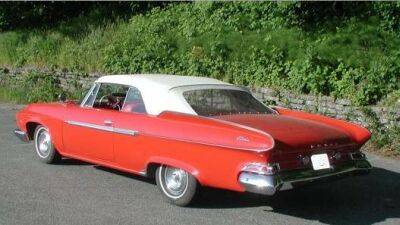
Comments: The D500 performance option was offered for the last time in 1961, but it was toned down from the year before. It now included a standard four barrel carb, or optional ram induction dual carbs (which were standard the year before).
Production: The 361 engine was slightly detuned for 1961, but that was overshadowed by the introduction of a new 383 cid V8 option, in either Police or Ram trim.
Engines: 318 V8 (2bbl) 230 bhp @ 4400 rpm, 340 lb-ft @ 2400 rpm. 318 V8 (4bbl) 260 bhp @ 4400 rpm, 345 lb-ft @ 2800 rpm. 361 V8 305 bhp @ 4800 rpm, 395 lb-ft @ 3000 rpm. 383 (Police) V8 325 bhp @ 4600 rpm, 425 lb-ft @ 3200 rpm. 383 (Ram) V8 330 bhp @ 4800 rpm, 460 lb-ft @ 2800 rpm.
Performance:
1962 Dodge Dart
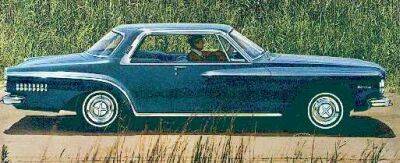
Comments: 1962 saw the peak of Dart performance when Dodge offered its 413 Max Wedge in all fullsize models, from the bare bones Dart 330 through the top of the line Polara 500. Most racers preferred the lighter and cheaper Darts. The 413 Max Wedge was manufactured under precise conditions at Chrysler’s Marine and Industrial Division and was a no-nonsense racing powerplant not intended for everyday operation. The 413 Max Wedge was offered in two forms: one with 11:1 compression rated at 410 bhp and the other with 13.5:1 compression rated at 420 bhp. The “Max” refered to the Maximum Performance label used in factory advertising while the “Wedge” refered to the 413’s Wedge shaped combustion chambers (as opposed to the earlier Hemispherical designs). Priced at just $374.40, the 410 bhp 413 was affordable and powerful. The Max Wedge featured free-flowing cast-iron headers, a dual exhaust system that featured cutouts that could be unbolted for unsilenced, wide open running. Heavy duty dual valve springs in the heads meant valve seals couldn’t be installed, making the engine a serious oil burner. The Max Wedge also featured a reinforced block and heads, a forged steel crank, Magnafluxed forged steel connecting rods, lightweight aluminum pistons, beefed-up valvetrain, and a deep-sump oil pan. Topping it off were two Carter AFB carbs mounted diagonally on a cross-ram intake featuring 15 inch individual runners.
As for styling, the Dodge Dart was all new for 1962, and sat on a 116 inch wheelbase, three inches shorter than a normal fullsize vehicle. Worse, Darts were saddled with some of the ugliest styling ever to be seen on an American vehicle. This would be the last year for a “fullsize” Dart as the name would be transfered to a true compact vehicle.
Production:Engines: 318 V8 (2bbl) 230 bhp @ 4400 rpm, 340 lb-ft @ 2400 rpm. 318 V8 (4bbl) 260 bhp @ 4400 rpm, 345 lb-ft @ 2800 rpm. 361 V8 305 bhp @ 4800 rpm, 395 lb-ft @ 3000 rpm. 383 (Police) V8 325 bhp @ 4600 rpm, 425 lb-ft @ 3200 rpm. 383 (Ram) V8 330 bhp @ 4800 rpm, 460 lb-ft @ 2800 rpm. 413 Max Wedge V8 410 bhp. 413 Max Wedge V8 420 bhp.Performance: 413/410 bhp: 0-60 in 5.8 seconds, 1/4 mile in 14.4 seconds @ 100 mph.
Plymouth Superbird 1970
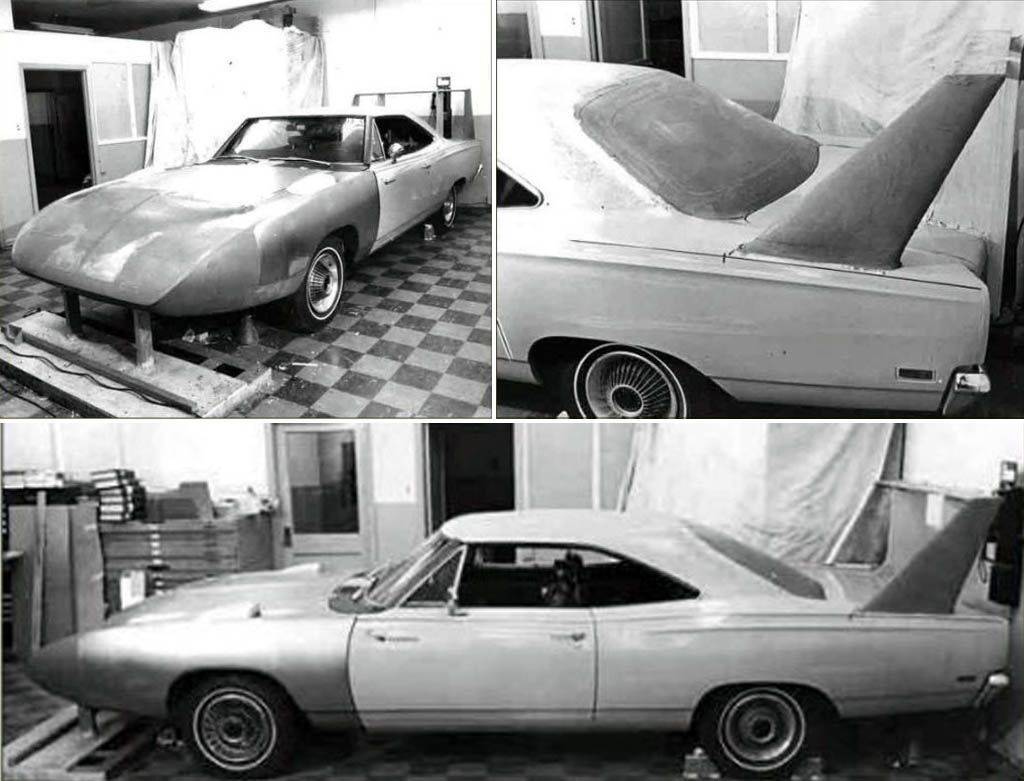
В процессе разработки Plymouth Superbird был учтен опыт постройки Dodge Charger Daytona
Когда стало понятно что формула по которой скроен Dodge Charger Daytona отлично работает, в Chrysler создали аналогичную гоночную машину — Plymouth Superbird. Автомобиль был построен на основе Plymouth Road Runner и внешне был очень похож на Daytona. Но на самом деле, у машины был оригинальный обтекатель и антикрыло с большим углом наклона. Кроме того в Superbird имелось множество вентиляционных отверстий, что благоприятно сказалось на охлаждении мотора.
Как и Дайтона, Суперберд оснащался двигателем 426 Hemi мощностью 425 л.с. и четырехступенчатой механической коробкой передач.


